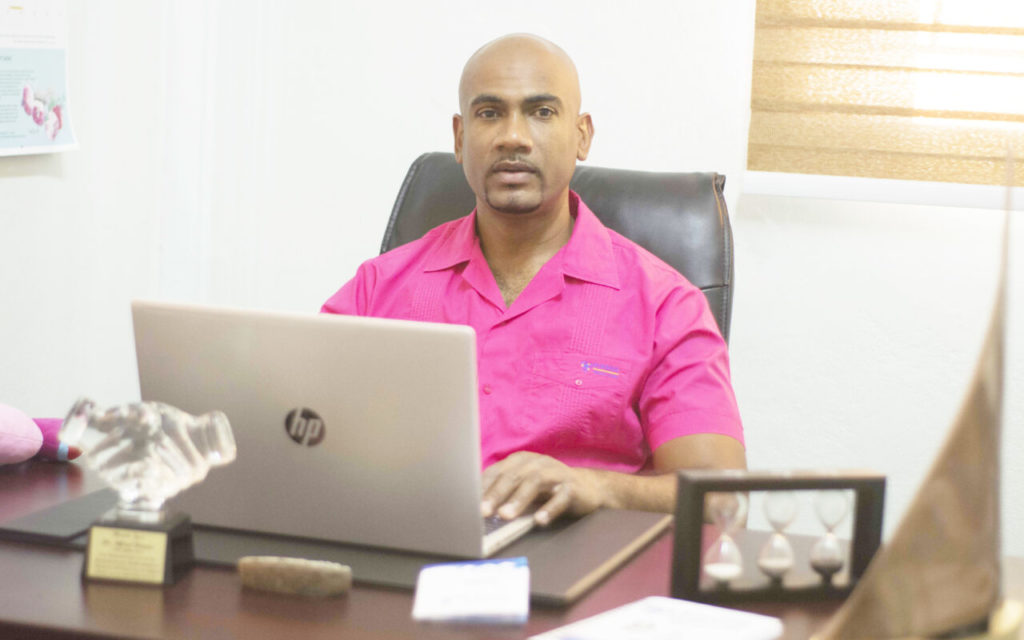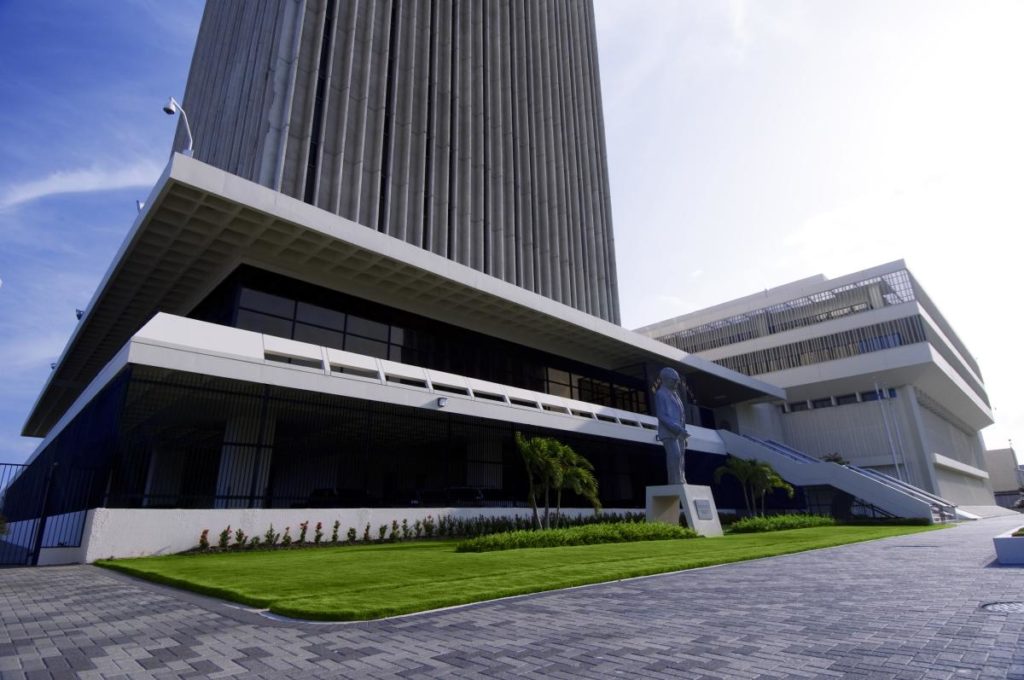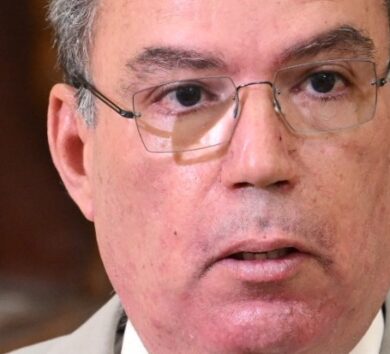

The following is the 2022-2023 Sectoral Debate contribution of Lisa Hanna, opposition spokesperson on foreign affairs and foreign trade, made on April 26.
In 1997, Tiger Woods made history when he won the coveted Masters’ Tournament golf championship with the widest margin of victory. At 21 years old, he had achieved professional golf greatness. So what did Tiger Woods do immediately after winning the tournament? He reviewed his methods and completely changed his swing. Why? To increase his competiveness for the future.
Analysts declared that Tiger’s habit of constant innovation made him stay ahead of the curve and gave him dominance during that period. Furthermore, his demonstration of not relying on his past victories for relevance provided bold leadership and disrupted the traditional norms of the sport.
It takes bold leadership with fearless innovation to transform anything, whether yourself, a sport, or a relationship. These skills are even more critical for improving a country and its people, especially in this interconnected, fast-paced world; policymakers must create the economic climate and mindset to grow a nation’s economy, precisely, the per capita income of its citizens.
Our Jamaican people are awake to possibilities; they look to us for courageous decision-making to improve their lives. But, sadly, what we discuss in this parliament and eventually implement gives them scarce opportuniFes to harness their potential for future progress, and their hope is waning.
The decisions we make in here impact the masses of our people, we must be deliberate with fierce urgency as there is such a thing as being too late, and I fear we are at that brink.
At this moment, we have no time for apathy or complacency. On the contrary, this is a time for vigorous action to positively change our people’s fortune and increase Jamaica’s global competitiveness for the future.
It’s Time for Bold Thinking
Jamaica, Singapore, and the United Arab Emirates were once colonies of Great Britain that became independent between 1962 to 1971. Although different in culture, all three had the same commitment: To build their economies and improve the lives of their people. Measuring the gross domestic product (GDP) per capita — Singapore is currently ranked fourth globally, the United Arab Emirates ranked 12th, and Jamaica ranked 146th, represenFng a real GDP per capita of US$98,400 for Singapore, US$67,100 for the United Arab Emirates, and US$9,800 for Jamaica. Therefore, the average person from Singapore can purchase ten Fmes more than the average Jamaican.
By comparison, the real GDP for these countries is US$561.3 billion, US$655.79 billion, and US$28.83 billion, respectively.
Why are these countries succeeding and we are not?
The data confirm two main reasons: These countries have an unswerving commitment to universal quality education for all their citizens, and their economies are geared towards value-added exports.
One of the main reasons for our dismal performance is that our systemic approaches to designing and implementing policies have not changed over decades. Subsequently, they are generally failing our people.
We have failed to offer quality education to most of our people and have pursued an economic policy of import substitution and protection for the past 50 years, which only creates monopolies to benefit a few.
Currently, Jamaica is ranked last in the English speaking Caribbean for literacy, “the lowest among the top five Caribbean countries in 2019 for annual labour productivity, and last in per capita exports in the region”.
I am sure the Opposition Spokesperson on Education will offer recommendations in her presentation. However, I will say this, today’s world is rooted in technology, with an economic axis that has shifted to the East driven by the millennials where the top 10 in-demand jobs did not exist 10 years ago.
In 1947 after its independence, India’s Prime Minister set in motion a broad vision for innovations in science and technology to shape their economy for future growth. Fifty years later, 25 per cent of India’s population with the highest I.Q. was greater than the total population of children living in the USA. India had more children receiving academic honours than the United States had children.
Their leaders had a vision for the people and pursued a strategic path that paid strong dividends, not only for its gross domestic product (GDP) but also for the global good. What we are witnessing today isn’t by accident or luck. India ranks in the top 15 countries for pharmaceutical exports. Indian pharmaceuFcal companies currently supply over 80 per cent of the world’s AIDS antiretroviral drugs and 20 per cent of all generic medicines.
Even before the COVID-19 vaccine was developed, India supplied approximately 100 countries with hydroxychloroquine and paracetamol. The Indian pharmaceutical sector, which was valued at US$64 billion in 2019, is now expected to grow to over US$150 billion by 2025. Moreover, Indians are the CEOs of some of the world’s top companies: Microsoft, IBM, Google, Micron, Adobe, Twitter, and Pepsi Co., just to name a few.

There is no new world coming. It is already here. We must pick winners to grow our economy, train our youth for the existing jobs, and redesign our education system around building talent in areas we can compete globally, so our productivity improves so we don’t continue to lose our best and brightest to overseas opportunities.
Our import substitution policy, which is broad-based and still being pursued today, is a dead-end for several industries and has not created an export-driven economy or led to any significant export of manufactured goods despite substantial duty protection over decades.
Over the past 10 years, we consistently imported four times more than we exported; over the past 40 years, the Jamaican economy has only experienced anemic growth, and per capita income has grown only marginally in real terms while that of other countries has improved significantly above ours;
For example, our agricultural policy supports the protection of the local Irish potato industry, not because we have any competitive advantage in growing Irish potatoes, not because we can compete on the world market in Irish potatoes. Still, instead, we put on blinkers and think that saying it is locally produced justifies the decision to protect and incentivise it.
Our production cost to produce locally grown Irish potatoes is 750 percent above the world market. The current farm gate price is US$1.14 per pound or $176.00 per pound. The world market price of Irish potato is US$0.15 per pound or J$23.00, so Jamaicans pay more than seven and a half Fmes the world market price for this product. There is no value in producing any agricultural product when we cannot do it efficiently and cost-effectively or at least 40 per cent above world market prices. Instead, we remain focused on banning imports or having “preferred importers,” which only serve to create agricultural monopolies to benefit a few.
Our attention and resources should be laser focused on the items we can export. One more acre of Irish potato is one less acre of exportable peppers, ginger, papaya, mangoes, or, more importantly, for value-added products to make sauces and cannabis products. Unfortunately, we seem not to have learned any lessons from staying too long in sugar.
Last year Jamaica imported more than US$31 million ($4.8 billion) in chicken back and turkey neck, most of which were resold at $250 per pound. Instead of the good cuts, why do we repurchase so much chicken and other offals? Simply, it comes down to what many Jamaicans can afford to eat daily. More than 70 per cent of our populace has insufficient resources to access safe or nutritious foods. (Jamaica Health and Lifestyle Survey III, 2016-2017)

Local chicken prices to Jamaican consumers increased five times last year. One pack of two leg quarters now retails in some supermarkets for $1,069 per kg ($488 per pound). That’s almost 3.25 times more than the retail price in the U.S.
Chicken back is what is left of the chicken when the prime cuts are taken away. It is 44 per cent bone and mostly skin, containing a small piece of meat called the oyster. The US has no market for these goods, so they’re usually dumped here. Nor is there a market in the US for beef offals, namely, livers, kidneys, tongues, and tripe. Those are also sent to Jamaica, where we consume over US$12.8 million (J$1.9 billion).
Therefore, any increase in our exchange rate increases the cost of these items. As inflation continues to increase worldwide, many Jamaicans will not be able to afford even these items of minimal protein, so they turn to foods to help them feel full, like rice and flour, to build out a meal. Jamaica’s import bill for rice annually is in excess of US$85 million ($13.2 billion).
As a result, for many Jamaicans, “dem belly full but dem hungry di pot a boil but di food nuff”. Why? Because Jamaican pay among the highest food prices globally, whether locally grown or imported, when our main objectives should be to increase our people’s overall wealth or reduce the food cost to the majority of our people.
Instead, we should focus on the export of organic chicken by small farmers. In the US, organic chicken or our ‘yard fowl’ sells at U.S$4.99 or JM$750 per pound. The upscale Whole Food Brand markets sell organic boneless and skinless chicken breast for U.S.$8.99 or JM$1350 per pound.
The rest of the world has been eating healthier with organic and non genetically modified foods. These areas represent two of the fastest-growing segments of the food industry. The global demand for non-GMO food was over US$1.49 trillion last year. What would it take for us to export our organic ‘yard fowls’ and contribute to this global supply chain?
The global ganja/cannabis and pepper sauce markets are expected to reach US$97.3 billion and US$3.77 billion, respectively, by the end of 2026. To succeed in exporting any of these products at even a one per cent world market share would transform Jamaica into the country we all yearn for. So, perhaps, we should focus on exporting scotch bonnet peppers and value-added products from the scotch bonnet using the foreign exchange to buy all the Irish potatoes we need at lower prices.
It is time to review our methods to structurally transform our economy for diversification, seeing ourselves as a value-added export country focusing on products and services to increase our global competitive advantage for the future. Other countries have changed their ‘swing,’ and it’s time Jamaica does so too.
We Need a Sun Sand Sea Makeover
In the summer of 2020, Prime Minister Mia Mottley announced that Barbados was accepting applications for its new ‘Welcome Stamp Program’. Under this programme, special visas had been approved, giving people from anywhere in the world the opportunity to relocate to the island, live like a Bajan, place their children in school, and work remotely for one year.

Mottley figured that since the novel coronavirus pandemic had changed the global business landscape to have large numbers of people working from home, why not invite them to do it in paradise?
Very soon after, my friend, her husband, and their two children jumped on a plane and headed to Barbados. As the vice-president of a Fortune 500 company, she went to work every day online. Her children aiended school. They all experienced a better quality of life while California grappled with the pandemic.
One year later, the Barbados Minister of Home Affairs Wilfred Abrahams announced that the programme, which received 2,810 applications from more than 100 countries, was a resounding success with significant multiplier advantages to the economy. As a result, the Bajan House of Assembly introduced the Remote Employment (Amendment) Bill in June 2021 to extend the visas for over 3,000 people who chose to make Barbados their home during the pandemic.
Why doesn’t Jamaica lean in and develop a similar model? Or, rather, why don’t we market Jamaica as a retirement and global wellness destination? I gave solutions to build a retirement tourism sector in 2019. Globally, between 14,000,000 to 16,000,000 patients traveled outside their home countries to seek medical treatment in 2017. Unlike traditional tourism, which gives revenues of US$113 per person per day spent by stopover visitors, medical tourism has the potential to generate higher earnings of approximately US$1,300 per medical tourist per day.

Dr Alfred Dawes, who specialises in high-end weight-loss surgical procedures, says it will be difficult for Jamaica to build out this industry to be globally priced competitive, as the costs for medical inputs and the tools of trade remain extremely high compared to other countries already in the business.
For example, the cost of a stapler to divide the stomach in laparoscopic surgeries is four times the cost in Jamaica versus Brazil. Moreover, surgeons who do not have their own private operating facilities must factor in the rental and other associated costs for procedures. For example, in Mexico, the total cost for laparoscopic surgery is US$8,000, while in Jamaica, the hospital fee alone runs up to US$7,000.
Additionally, the global wellness sector (industries that enable consumers to incorporate wellness activities and lifestyles into their daily lives) is growing rapidly. The Global Wellness Institute disclosed that the global wellness economy generated US$4.4 trillion in revenue during 2020, while the wellness tourism sector accounted for US$436 billion. Wellness tourism is growing 50 per cent faster than traditional tourism, as people seek places and spaces to replenish their mind, body, and soul with exercise and spa skin care treatments. What is more, Cosmetics are now using thermal mineral water for products collected directly at the source devoid of artificial processing. Europeans have been using mineral waters to heal skin irritations and inflammation.
For example, the luxury La Mer skincare line, which Estée Lauder owns, retails one 3.4-oz bottle of its face serum at US$900. In 2018 La Mer contributed over US$1 billion to the company’s net sales. Their moisturiser comprises sea kelp, vitamins, and minerals.
Jamaica has three known mineral springs — Milk River in Clarendon, Bath in St Thomas, and Rockfort in St Andrew. These springs are unique as they each possess varying levels of calcium, magnesium, sodium, sulfate, potassium, bicarbonate, silica, chloride, iron, and copper.
Evidence suggests Milk River is more radiative than leading European spas, being 54 times more active as Baden in Switzerland and five times as active as Karlsbad, Austria, reputed to cure numerous ailments including rheumatism, gout, neuralgia, sciatica, lumbago, nerve conditions, and liver disorders. (Milk River Hotel and Spa Annual Report 2019-2020)

The Milk River Bath is a natural resource that has been relevant since it opened in 1794. But the facility needs a major makeover in its branding, image, and service, which are crucial to harnessing its real potential. The facility’s annual report presented earnings of $51.3 million in 2020. Of this amount, the Government gives an $18-million subvention. These earnings pay $24.5 million in salaries, $16.8 million for goods and services, and $348,000 for capital expenditure. All told, Milk River Hotel and Spa generated a profit of $2.7 million.
Our brand gives us a unique advantage in attracting wellness travelers. Therefore, let us build an actual boutique luxury spa facility to rival the best in the world and produce a line of Milk River luxury skincare and cosmetic products using the properties of the Milk River mineral spring.
Jamaican Bottled Water is a Billon Dollar Industry
Not only is the boiled water market thriving worldwide, but its volume has also surpassed carbonated beverages, and it will conFnue to grow due to changing consumer spending habits, healthier lifestyle trends, and declining access to clean and safe drinking water in densely populated cities.
The global boiled water industry was worth approximately US$230.4 billion in 2020. It is projected to grow annually with accumulated revenue of roughly US$405 billion by the end of 2027 (BlueWeave Consulting 2021).
The rising consumer awareness of the health benefits of boiled water will continue pushing the global demand and product sales, especially among younger consumers. Following this trend, several restaurants are expanding their boiled water offerings to meet this demand. Among the boiled water varieFes ranging from spring, purified, mineral, and sparkling, it is the purified water segment that holds the largest share — 35 per cent — in 2020 (Grand View Research, 2021).
According to the United Nations, almost 16,000 desalination plants across 177 countries provide purified water. Increasing water needs due to populaFon growth, increased per capita water consumption, urbanisation, economic development, and falling water supplies due to climate change and contamination exacerbate water scarcity in most regions of the world (U.N., 2018).
In 2018 Mexico and Thailand had the highest per capita consumption of boiled water worldwide at 72.4 gallons per person. Over the last ten years, the United States’ annual bottled water consumption grew by almost 40 per cent. The United States imported around US$762 million worth of water in 2020 (336 million litres from Italy and 248 million litres from Fiji).
Why isn’t Jamaica exporting a national boiled water brand globally?
Fiji water started in 1996 and now ships boiled water to all continents and commands US$150 million in annual sales from the United States alone. Fiji’s population stands at 894,444, slightly more than a quarter of Jamaica’s population.
If Jamaica were to position itself to carve out half a per cent of the global boiled water market share, we would have a national export industry worth anywhere between US$1 billion to US$2 billion. This is an achievable goal.
Excluding bauxite and alumina, our current national exports for 2020 were approximately US$246 million or JM$37.4 billion.
* rum — US$56 million
* yam — US$30 million
* coffee — US$11.9 million
*baked products — US$22.2 million
*ackee — US$20.2 million
* sauces — US$24 million
* scrap metal — US$11.6, and
* chemicals — US$31.6 million (Source: Economic and Social Survey Jamaica, 2020)
Significantly, Jamaica has won the award from the Caribbean Water and Wastewater Association for the best quality drinking water in the region three Fmes in a row in 2012, 2013, and 2014. Our country is blessed with good clean water, which gives us a serious advantage. We have natural water springs that can be boiled at the source and sold worldwide.
The business of water has a value chain that favours retail. The production of bottled water carries a relative cost of production between US$0.12 to US$0.15, and the consumer purchases it at US$0.50 to US$1.00. The packaging, branding, and marketing of the water have higher cost inputs than the product itself.
Jamaica has a global competitive advantage as a brand already based on the representation of the international excellence Jamaica wields in track and field, music, and entertainment. Additionally, we are ranked in the top three of the world’s “coolest countries” ( CNN Travel, 2017). Although most bottled water brands are consumed recreationally, consumers are influenced by the personalities and brand ambassadors associated with the beverage and the obvious perceived health benefits of water.
Therefore, Brand Jamaica gives us a solid opportunity to build a bottled water product with our iconic unmatched personalities and our flora and fauna. Just the name Jamaica packaged right on a boile and positioned in Asia, Europe, or North America would be powerful.
When the Arawaks saw Christopher Columbus “discovering” Jamaica, liile did they know then this would disrupt their lives. As a country, we have allowed too many external forces to discover, own, and patent the things that are naturally ours. Let’s not allow another foreigner to discover that our Jamaican water is a US billion-dollar export industry. Let’s do this one on our own.
Let’s Brand the Metaverse with Jamaica NFT lifestyle
Some 174 years ago, Robert Richards Torrens developed a registration system for titles that allowed for a central register to record the legitimate owner of a property and provide that owner with a duplicate certificate confirming their ownership. This system was the foundation for real estate commerce and mortgage financing.
Fast-forward to the 1990s, when the Internet revolutionised our world. Today, if you search your bank balance online, those funds are not physically sitting in the bank. You see an “I owe you” from the bank to pay that amount on demand in the denominated currency.
We already depend on computers to account for our currency ownership, so why not everything else we own? The next phase of the Internet, referred to as Web3 or Web 3.0, is here, and the world you’ve become accustomed to is morphing into a digital one with each passing day.
Now you can digitally register ownership of anything with cloud registration, also known as a blockchain, to which everyone has access. Last year, the psychological hype around digital value confused people in the main as to what was a token and why were Bored Ape Yacht Club NFT tokens being resold for millions of US dollars online?
An NFT is a unique certificate of registration of a digital asset or a one-of-a-kind digital asset that belongs only to you. It is a unique unit of data employing technology that allows digital content to be logged and authenticated on cryptocurrency blockchains, primarily Ethereum. NFTs can be individual or part of a collection, allowing their owners to feel as though they are joining an exclusive online community. The most popular NFTs right now include artwork and music, videos, and personal tweets.
The metaverse is here and growing every day; whether you choose to accept it, you need to understand it. Experts say it is essential to the next phase of the Internet, and top brands are wasting no time developing original NFT products that can trade in this alternate universe. For example, Adidas Originals, the fashion and lifestyle subdivision of the German sportswear giant, is launching an NFT collection of both physical and digital products through digital and physical comic books, created in collaboration with a host of trending metaverse players.
Jamaica is a global brand. However, we have not benefited economically from this value, while others use our intrinsic labels such as reggae, Jamaican Jerk, and ‘Made in Jamaica’. The world has now entered a new phase, and there is the possibility for a teenager in Brazil to design, own, and sell digital Jamaican NFT products, iconic images, and historical moments 100,000 times over. In fact, people could travel to “Virtual Reality JA” without stepping on a plane. And guess what, it’s already happening.
Therefore, this is a call to action for the Government to develop legislation for our Jamaican artists, musicians, and content creators to monetise their content by leapfrogging their minds to this new reality of digital ownership, management, and sale using cryptocurrency. If Twitter CEO Jack Dorsey could sell his first tweet as an NFT for US$2.9 million to a buyer in Asia, and Lebron James could turn his “cosmic” dunk video into an NFT for US$397,600, then the sky is the limit the some more of our content creators like Bonito Thompson AR artist Don Dada.
Conclusion
The late Professor Aggrey Brown was my teacher, my mentor, and my friend. I remember back in 1993, when he and I spoke about globalisation and culture; he told me:
“All things are connected. Whatever befalls the earth befalls the sons of the earth. Man did not weave the web of life; he is merely a strand in it. Whatever he does to the web, he does to himself” (Chief Seaile)
The truth is we are all connected. I stand here once again grateful to be able to serve Jamaica, but I did not create this opportunity by myself. It is through a collective weaving of individuals and groups who have contributed to who you are seeing and hearing: the people of SESA, my constituency office staff, the PNP, my colleagues on both sides of the house, my current Leader of the Opposition and past leaders and Prime Ministers, the parliamentary team, my son, my husband, and my family. As a result, I have had the opportunity to serve my country over the past 15 years. I don’t take this responsibility lightly because I know whatever I do, has repercussions for everyone now and for others coming behind them.
Therefore I have a duty, and we all have a duty to build this nation and create opportunities for others so that when we are gone, the generations we leave behind will say we were ahead of our time.
This is why I warned on February 21, 2022, of the perilous state the world would plunge into should Russia invade Ukraine. I thought that not only would the world’s largest economies impose financial sanctions on Russian banks, but any conflict and the associated sanctions would have a devastating impact on the production and export of food to Western markets and the largest wheat importers in the Middle East and North Africa (MENA) — Turkey, south-east Asia, and sub-Saharan Africa. This would deepen the current global food crisis and aggravate the severe supply chain disrupFons due to the pandemic. Furthermore, sanctions would reduce Russian oil supplies, immediately driving up global oil prices.
Unfortunately, many Jamaicans did not understand the extent of how a Russian military invasion of Ukraine would directly impact their personal lives, declaring, “It’s their war and not our problem; we need to focus on ourselves.”
The fact was and still is that we are all connected, and war impacts everyone globally, including Jamaica. Beyond the humanitarian catastrophe, there are broader and longer-term geopolitical and economic implications from the conflict that will affect global supply chains, energy and food sectors, and many other industries directly and indirectly (APCO Worldwide).
The Russian Federation is the second-largest oil producer in the world, producing 10.1 million barrels per day of crude oil and natural gas condensate (2021 B.P. Statistical Review of World Energy) and ranked as the top exporter of nitrogen (N) fertilisers, and the second-leading supplier of both potassic (K) and phosphorous (P) fertilisers.
There are 25 countries that are dependent on supplies of Russian fertiliser. Last year, Russia stood out as the top global wheat exporter, shipping 32.9 million tonnes of wheat and meslin, or 18 per cent of international shipments. Ukraine stood as the fifth-largest wheat exporter in 2021, exporting 20 million tonnes of wheat and meslin and a 10 per cent global market share. Russia and Ukraine held nearly 30 percent of the worldwide market share of wheat exports.
Ukraine also produces half of the world’s sunflower seed oil; the substantial production bases of both themselves and Russia in the global maize, barley, rapeseed, and sunflower oilseed markets gave a combined world export market share of close to 64 per cent. Approximately 50 nations rely on these two countries for roughly 30 per cent of their wheat import needs.
Although this war is thousands of miles away, it has already had devastating effects on other people’s personal lives worldwide. The pockets of the poor have been hit the worst, and Jamaicans have not escaped the fallout.
For example, global prices for crude oil went to US$125 a barrel, compared to US$58 per barrel one year ago. The oil price cost affects everything — commercial and domestic electricity, transportation, and food production. What’s more, the cut-off of these significant global suppliers of wheat, sunflower oil, and fertiliser will significantly increase the prices of some of the essential commodities (e.g., flour and cooking oil) and could potentially create an agricultural food security crisis without the access to fertiliser for the planting and harvesting of spring crops.
So is the Russian Ukraine war a Jamaica problem? In summary, yes. The cost of food, electricity, transportation, mortgage payments, rent, construction supplies, and gas/fuel have increased and are expected to continue rising. It will affect hire purchase rates and the cost of borrowing money for employers and reduce job creation by making investing more expensive.

Over the past eight months, the Bank of Jamaica has moved its benchmark interest rate from 0.5 per cent to 4.5 per cent. While this may take some time to impact personal interest rates, it will be debilitating to an individual’s disposable income when it does.
Out of 146 countries worldwide, Jamaica stands at 142 with the highest electricity charges. There are only four countries that pay more for electricity than we do. Add this to a 30 per cent increase in electricity and transportation costs, along with a 20 per cent increase in food, and we will see an emergency.
I have consistently stated that Jamaica will never have true prosperity if we focus only on creating and selling products for our populace of three million. Our import substitution policy needs to be replaced by an urgent value-added, export-driven agenda.
Furthermore, we need to urgently establish a Food and Energy Crisis Task Force to foresight, forecast, and plan effectively for our economy due to the global shocks caused by the Russian Ukraine crisis. Our dependence on international trade for raw materials, food production, oil, and fertiliser dictates that we cannot adopt a wait-and-see astude. Instead, we must be proactive and strategic now to globally reposition Jamaica given opportunities and a careful analysis of the goods and services we have or can develop a competitive export advantage.
We possess natural beauty; creative people; soil that gives our food an incomparable taste profile; proximity to North America (the largest consumer market in the world); and geographical positioning to take advantage of Europe, South America, and Asian trade routes.
Short-term Band-Aids cannot remain our go-to response to building our country and people. As a country, we seem to be walking backward into the future with our eyes wide shut as so many Jamaicans fret daily and remain invisible. This strategy has goien us nowhere globally or even regionally. The many travels to and from seem like tokenism and picture ops, as FDIs continue to evade us like Tom chasing Jerry.
The international benchmark used is thirty murders per 100,000 people to establish a state of civil war. We are at approximately 46.2 murders per 100,000, ranked the second in the world for killing women and overall murder. Since 1962 Jamaica’s murder rate has increased by 2040 per cent which is 18 per cent of our male population between 15-34 years old, contributing to 75 per cent of the murders being committed. If we don’t break this momentum, the dark reality is that in another 60 years, this war with ourselves could see whiteness over 26,000 Jamaicans being killed between January to November in 2081.
In this era, we should do what we must, so we can eventually do what we want, and though some of the policies that we may need to put in place might not be politically expedient, we have to develop the courage to get it done. Or our purpose will redound to being road fixers, Easter Bunny’s, Mrs. Claus, the lesser of two evils, and at times, Fedex – expected to give out packages year after year.
There is fierce urgency now calling on us to change our old habits, meaningfully engage in working cooperatively across the aisle, and look toward sustainability so we can give our people a lifestyle to afford good protein and nutritious food daily to feed themselves and their families, keep them safe in violent free communities, and educate them to compete with the best in the world.
It’s time we change our swing.






Comments